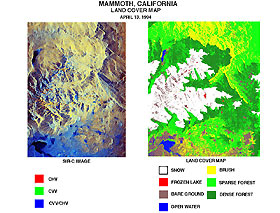
Save this image free of charge
in 800 pixels for layout use
(right click, Save as...)
|
|
Ref : V01812
Theme :
Looking at Earth - Cities (375 images)
Title : Space Radar Image of Mammoth, California
Caption :
These two images were created using data from the Spaceborne Imaging Radar C/X-Band Synthetic Aperture Radar (SIR-C/X-SAR). The image on the left is a false-color composite of the Mammoth Mountain area in California's Sierra Nevada Mountains centered at 37.6 degrees north, 119.0 degrees west. It was acquired on- board the space shuttle Endeavour on its 67th orbit on April 13, 1994.In the image on the left, red is C-band HV-polarization, green is C-band HH-polarization and blue is the ratio of C-band VV-polar- ization to C-band HV-polarization. On the right is a classifi- cation map of the surface features which was developed by SIR-C/ X-SAR science team members at the University of California, Santa Barbara. The area is about 23 by 46 kilometers (14 by 29miles). In the classification image, the colors represent the following surfaces: White snow Red frozen lake, covered by snow Brown bare ground Blue lake (open water) Yellow short vegetation (mainly brush) Green sparse forest Dark green dense forest Maps like this one are helpful to scientists studying snow wettness and snow water equivelent in the snow pack. Across the globe, over major portions of the middle and high latitudes, and at high elevations in the tropical latitudes, snow and alpine glaciers are the largest contributors to run-off in rivers and to ground-water recharge. Snow hydrologists are using radar in an attempt to estimate both the quantity of water held by seasonal snow packs and the timing of snow melt. Snow and ice also play important roles in regional climates; understanding the processes in seasonal snow cover is also important for studies of the chemical balance of alpine drainage basins. SIR-C/X-SAR is a powerful tool because it is sensitive to most snow pack conditions and is less influenced by weather conditions than other remote sensing instruments, such as the Landsat satellite.Spaceborne Imaging Radar-C and X-Synthetic Aperture Radar (SIR-C/X-SAR) is part of NASA's Mission to Planet Earth. The radars illuminate Earth with microwaves allowing detailed observations at any time, regardless of weather or sunlight conditions. SIR-C/X-SAR uses three microwave wavelengths: L-band (24 cm), C-band (6 cm) and X-band (3 cm). The multi-frequency data will be used by the international scientific community to better understand the global environment and how it is changing. The SIR-C/X-SAR data, complemented by aircraft and ground studies, will give scientists clearer insights into those environmental changes which are caused by nature and those changes which are induced by human activity.SIR-C was developed by NASA's Jet Propulsion Laboratory. X-SAR was developed by the Dornier and Alenia Spazio companies for the German space agency,Deutsche Agentur fuer Raumfahrtangelegenheiten (DARA), and the Italian space agency, Agenzia Spaziale Italiana (ASI), with the Deutsche Forschungsanstalt fuer Luft und Raumfahrt e.v. (DLR), the major partner in science, operations and data processing of X-SAR.
|
|

